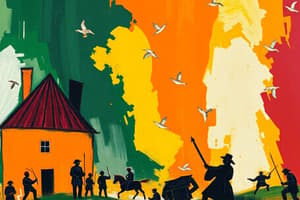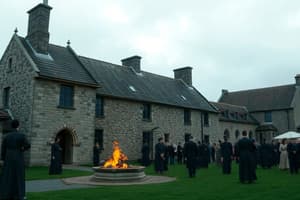Podcast
Questions and Answers
When did the Irish Bronze Age proper begin?
When did the Irish Bronze Age proper begin?
- Around 10,500 BC
- Around 4000 BC
- Around 600 BC
- Around 2000 BC (correct)
When did the arrival of the Beaker Culture mark the beginning of the Copper Age in Ireland?
When did the arrival of the Beaker Culture mark the beginning of the Copper Age in Ireland?
- Around 33,000 years ago
- Around 600 BC
- Around 9700 BC
- Around 2500 BC (correct)
When did the La Tène culture bring new styles and practices to Ireland?
When did the La Tène culture bring new styles and practices to Ireland?
- Around 4000 BC
- By 300 BC (correct)
- Around 10,500 BC
- Around 600 BC
When did Christianity begin to gradually replace the earlier Celtic polytheism in Ireland?
When did Christianity begin to gradually replace the earlier Celtic polytheism in Ireland?
When did the Younger Dryas cold phase occur?
When did the Younger Dryas cold phase occur?
When did the earliest confirmed inhabitants arrive in Ireland?
When did the earliest confirmed inhabitants arrive in Ireland?
When did the Neolithic culture, characterized by pottery and megalithic tombs, start to appear in Ireland?
When did the Neolithic culture, characterized by pottery and megalithic tombs, start to appear in Ireland?
Where is the Céide Fields located?
Where is the Céide Fields located?
When did the Irish Copper Age and subsequent Bronze Age come to Ireland?
When did the Irish Copper Age and subsequent Bronze Age come to Ireland?
What is argued to have depopulated Ireland during the Younger Dryas?
What is argued to have depopulated Ireland during the Younger Dryas?
What type of monuments developed near the end of the Neolithic in Ireland?
What type of monuments developed near the end of the Neolithic in Ireland?
What is the Céide Fields known for?
What is the Céide Fields known for?
When did the Norman invasion lead to over 800 years of English political and military involvement in Ireland?
When did the Norman invasion lead to over 800 years of English political and military involvement in Ireland?
What event marked the defeat of Gaelic Ireland and the beginning of Ireland's history as part of the English and later British Empire?
What event marked the defeat of Gaelic Ireland and the beginning of Ireland's history as part of the English and later British Empire?
When did Ireland become part of the United Kingdom of Great Britain and Ireland?
When did Ireland become part of the United Kingdom of Great Britain and Ireland?
What event marked the beginning of the prolonged Tudor conquest of Ireland?
What event marked the beginning of the prolonged Tudor conquest of Ireland?
What marked the defeat of Gaelic Ireland?
What marked the defeat of Gaelic Ireland?
When did the Great Famine strike Ireland?
When did the Great Famine strike Ireland?
When did the English Crown make another attempt to conquer Ireland after the Wars of the Roses?
When did the English Crown make another attempt to conquer Ireland after the Wars of the Roses?
When did Gaelic resurgence reestablish cultural preeminence over most of Ireland, apart from walled towns and The Pale?
When did Gaelic resurgence reestablish cultural preeminence over most of Ireland, apart from walled towns and The Pale?
When did the rebellion of the Hiberno-Norman Earl of Kildare Silken Thomas occur?
When did the rebellion of the Hiberno-Norman Earl of Kildare Silken Thomas occur?
When did the Scandinavian influence in Ireland cease to be a major threat to Gaelic culture?
When did the Scandinavian influence in Ireland cease to be a major threat to Gaelic culture?
When did the battle of Kinsale mark the defeat of Gaelic Ireland?
When did the battle of Kinsale mark the defeat of Gaelic Ireland?
When did the English Parliament abolish the Irish Parliament?
When did the English Parliament abolish the Irish Parliament?
Flashcards are hidden until you start studying
Study Notes
Ireland's Historical Timeline
- Many Irish towns were founded as Scandinavian trading posts, with the first appearance of coinage.
- Scandinavian influence in Ireland was limited and ceased to be a major threat to Gaelic culture after the Battle of Clontarf in 1014.
- The Norman invasion in 1169 led to over 800 years of English political and military involvement in Ireland.
- Gaelic resurgence reestablished cultural preeminence over most of Ireland, apart from walled towns and The Pale.
- The English Crown did not make another attempt to conquer Ireland until after the Wars of the Roses.
- Ireland's decentralized political organization, difficult terrain, and martial traditions made it challenging for the English to assert authority.
- The rebellion of the Hiberno-Norman Earl of Kildare Silken Thomas in 1534 marked the beginning of the prolonged Tudor conquest of Ireland.
- Ireland became a battleground in the wars between Catholic Counter-Reformation and Protestant Reformation Europe.
- English attempts to conquer or assimilate Ireland led to ongoing warfare, including notable rebellions and wars.
- The battle of Kinsale in 1601 marked the defeat of Gaelic Ireland and the beginning of Ireland's history as part of the English and later British Empire.
- The Irish Parliament was abolished on 1 January 1801, and Ireland became part of the United Kingdom of Great Britain and Ireland.
- The Great Famine struck Ireland in 1845, resulting in over a million deaths and a million refugees fleeing the country.
Studying That Suits You
Use AI to generate personalized quizzes and flashcards to suit your learning preferences.




